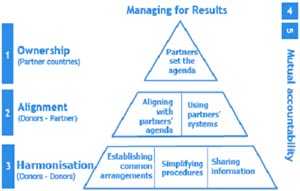 |
 |
 |
 |
||
|
|
|
1. Introduction |
|
|
|
With an emphasis on the 'Managing for Development Results' approach that is required for the successful implementation of the NSDP, our collective efforts to promote aid effectiveness are linked to the broader objective of promoting improved development outcomes. This requires that we pursue a more evidence-based approach to aid management, meaning that the collection, analysis and interpretation of the data becomes increasingly important. Only then can we document these lessons so that they can be fed back into the policy and decision-making dialogue. To establish a more complete understanding of the links between the NSDP and aid effectiveness it is useful to begin this Report by squarely addressing the question, "How is the aid effectiveness agenda linked to the achievement of development results?" The Harmonisation, Alignment and Results (H-A-R) Action Plan of the Royal Government is informed by the global aid effectiveness work and, in particular, the Paris Declaration. This Declaration, a compact between donor and partner countries, provides a framework that associates development effectiveness, i.e. the combined impact of all parties engaged in the national development effort, with five principles. These principles, presented in the pyramid below, represent the results-based initiatives that might be taken in each of the following areas: ownership; alignment; harmonisation; an explicit focus on and increased use of results-based approaches; and an acknowledgement of the role for mutual accountability in managing development partnerships. |
|
The links between harmonisation, alignment and improved development outcomes are often presented as self-evident. While there may indeed appear to be an intuitive link, there is still much that needs to be considered, however, if this causality is to be made conceptually useful so that practical lessons can be learned and applied. It is therefore necessary to develop a better understanding of the linkages between aid effectiveness work and results, and how we might expect improved management of development assistance to impact on development results. The following transmission mechanisms may be of particular relevance: |
 |
||||||||||||||||||||||||||||||
'Managing for development results' is therefore about more than collecting data, and much more than simply maintaining a scorecard of indicators. Both development partners and partner countries would agree that there is a pressing need to make our aid effectiveness work more operational; that there has been a significant effort made to change the manner in which aid is delivered, to establish any number of working groups and committees dedicated to discussing how this might be done, and yet the outcome in terms of development results have not always been immediately evident. In short, too much heat and not enough light. The challenge in linking development assistance to results is therefore to establish a better understanding of the nature of this linkage and then to make it operationally useful by strengthening national ownership and creating policy-relevant tools that can monitor results. These results can then be fed back into the policy-making and resource allocation processes. Aid Effectiveness: A Policy Imperative Having underlined the importance of our aid effectiveness work this Report uses sources that include the inputs submitted by TWGs to the GDCC, the 2006 GDCC-TWG Review, the OECD/DAC Paris Declaration monitoring survey, and the CDC Database to present a consolidated analysis that supports the effort to translate aid effectiveness efforts into development outcomes. This Report succinctly highlights the nature and scope of the coordination challenge in Cambodia and shows that, as is suggested in Table One, below, not only is the challenge formidable but that rising to it will be essential if NSDP outcomes are to be realised. Table One. Development Assistance: Indicators of Transaction Costs
Source: CDC Database and CDC Development Cooperation Report (various years, UN agencies counted individually) The Report also attempts to derive some practical policy-relevant lessons and demonstrates that, by making better use of data and empirical experience, we can provide policy makers with the evidence that is needed to ensure that development assistance provides effective support to the NSDP. This Report is therefore very much about effective aid coordination and 'managing for results': increased aid effectiveness is not presented as a policy choice but, rather, as a policy imperative. Chapter Two of the Report recounts the main activities of 2006 related to the development partnership and reflects on some of the main trends in development cooperation. Chapter Three provides an analysis of development cooperation activities in the context of the H-A-R Action Plan. Chapter Four reviews the process of establishing a baseline for monitoring aid effectiveness before Chapter Five attempts to provide some policy direction based on the evidence presented in earlier chapters. Chapter Six then concludes the Report by acknowledging that, while there is much to be done in terms of establishing robust data systems that will consolidate the aid effectiveness and development results linkages, there is sufficient evidence to show that aid management initiatives are making progress and that they can be expected to have a positive impact on the implementation of the NSDP. Throughout the Report an effort has been made to identify and to discuss emerging practices. In the case of those practices that are considered to have particular merit the Royal Government and development partners are encouraged to consider what makes them good practices and to consider if elements of them can be adapted and replicated. |
|||||||||||||||||||||||||||||||